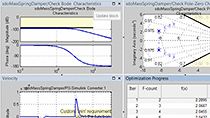Optimizing a Battery Electric Vehicle Thermal Management System
Dr. Lorenzo Nicoletti, MathWorks
Steve Miller, MathWorks
Range, safety, and passenger comfort are key criteria for consumers when purchasing a battery electric vehicle (BEV). The thermal management system of a BEV affects all these criteria. Engineers designing this system must ensure their design: - Maintains comfortable temperature and humidity within the cabin. - Extends range by minimizing energy consumption. - Extends component life by keeping the battery and motor within recommended temperature range. - Performs effectively even in extreme weather conditions.
For a system as complex as thermal management, multidisciplinary analysis of all relevant vehicle systems must be conducted. By developing a holistic simulation of the entire vehicle, engineers can optimize thermal management to ensure passenger comfort, minimize losses, and increase range. In this talk, see a Simscape™ model of a midsize BEV that enables virtual testing of the entire vehicle. The model includes the vehicle powertrain, driveline, and thermal management. First, the model is used to simulate the vehicle performance within a driving cycle to analyze the energy consumption. Then a sensitivity analysis is performed, assessing how different parameters impact overall vehicle performance in terms of range and consumption. Finally, numerical optimization is leveraged to identify design parameters that minimize the energy consumption for different climate scenarios. The sensitivity analysis and optimization workflows directly support Simulink® and Simscape models through a visual user interface in Simulink Design Optimization™. Optimization is performed using a surrogate optimization algorithm that is suitable for computationally expensive models. The overall process is accelerated using parallel computing on the cloud. This workflow could easily be extended to other design optimization applications involving Simulink and Simscape models.
Published: 7 Nov 2024




